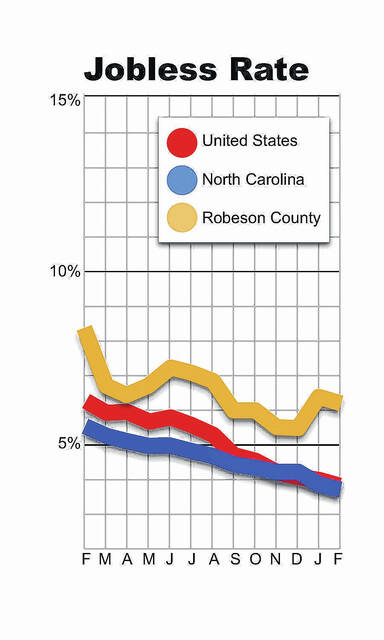
Data from the North Carolina Department of Commerce showed Robesonon County’s unemployment rate improved from January to February.
David Kennard | The Robesonian
Robeson County’s unemployment rate decreased slightly in February, according to a report released Tuesday by the North Carolina Department of Commerce.
At 6.2%, the county’s unemployment rate remained higher than the state average of 3.7% as well as the U.S. average of 4.1%, according to the report.
“Unemployment rates (not seasonally adjusted) decreased in 50 of North Carolina’s counties in February, increased in 12, and remained unchanged in 38,” the report stated.
Hyde County showed the highest unemployment rate of 8.9% while Orange County posted the lowest at 2.5%.
Of Robeson County’s closest neighbors, only Scotland County had a higher jobless rate (7.8%).
Like Robeson County, Bladen County (4.9%), Columbus County (5.1%), Cumberland County (5.5%) and Hoke County (5.1%) all saw their unemployment rates drop from January’s jobless rate. Additionally, all of Robeson County’s neighbors posted jobless rates significantly lower than February 2020 when businesses around the state still struggled from the COVID-19 impact.
In fact, according to Wednesday’s report, when compared to the same month last year, not seasonally adjusted unemployment rates decreased in all 100 counties. All 15 of the state’s metro areas experienced rate decreases over the year as well.
The Fayetteville Metropolitan Statistical Area, which is the closest to Robeson County, saw a slight drop from January (5.6%) to February (55%), which many economy watchers say is close to full employment, considering variables such as workers changing jobs or entering and exiting the workforce.
The Fayetteville MSA is one of nine of the state’s metro areas experiencing rate decreases; one increased, and five remained unchanged. Among those metro areas, Rocky Mount had the highest unemployment rate at 6.2%, while Durham-Chapel Hill had the lowest at 2.9%. The February not seasonally adjusted statewide rate was 3.7%.
“It is important to note that employment estimates are subject to large seasonal patterns,” the report states. “Therefore, it is advisable to focus on over-the-year changes in the not seasonally adjusted estimates.”
The next unemployment update is expected to be released on April 14 when the statewide unemployment rate for March.
Reach David Kennard at [email protected].






